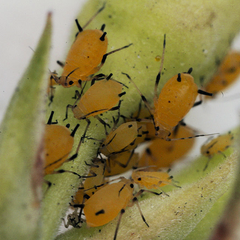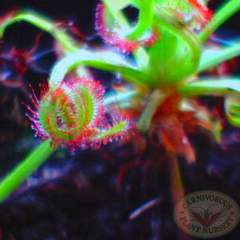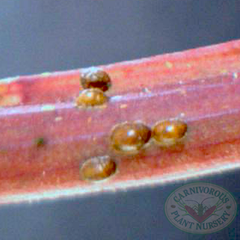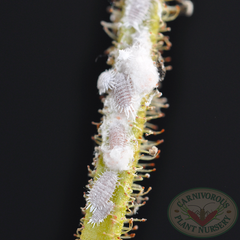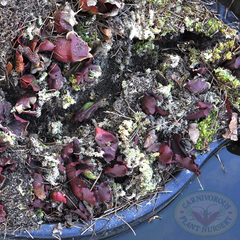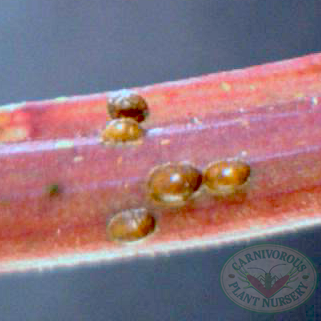
Pests on Carnivorous Plants
Pests of Carnivorous Plants
As a general rule, carnivorous plants eat insect pests, rather than are damaged by them. However, there are a few common carnivorous plant pests that are easily spotted and treated.
Aphids
This common plant pest often attacks the growing tips of new growth, and is most common in the Spring. They are often first noticed by the dried white shells of their shedding. In small numbers they can be left alone and will die off as the plant matures, but they can cause deformation of the leaves and traps that is unsightly. They can be controlled by physically removing them, gently squeezing them on the plant between your fingers or washing them off with a spray bottle. You may need to do this every week or two several times before they are eliminated. They seem to be more of an issue on emerging Venus Flytraps and Sundews than other carnivorous plants. To get rid of aphids on your sundew or flytrap, you can treat with Bayer Advanced Rose and Flower insecticide or use one of the methods mentioned above.
Mealy Bugs
Mealy Bugs can be quite a nuisance. These common, fuzzy, tiny white bugs in your terrarium feed on the juices of the plants and can harbor disease and infection. They often hide away from the light and can go unnoticed before they have done considerable damage. It is not unusual to find them hidden in the tight crevices of the lower portions of pitcher plant traps near the rhizome or even on the underside of the rhizome well below the soil and out of sight. They can quickly spread across your collection. They can be physically removed with your fingers, a Q-tip dipped in alcohol, or treated with Bayer Advanced Rose and Flower insecticide.
Scale
Scale is a small insect that looks much like a small fish scale stuck on the plant. They often occur in colonies and can spread if untreated. They are often detected by their sugary droppings that grow dark mold. Adults are permanently attached to the leaf or stem, often on the underside out of sight. Young scale insects do travel a short distance up or down the infected area. They are easily removed by gently scraping with your fingernail. They can be treated with Bayer Advanced Rose and Flower insecticide, but can be persistent and may need several treatments. Mechanical remove is best, when numbers are reasonable.
Spider Mites
Spider Mites are very tiny mites that feed through the undersides of leaves and traps. They spin a tell-tale protective silky web. They often leave the leaf or trap riddled with tiny holes giving the plant yellow spots or a greyish appearance. They can be treated with Bayer Advanced Rose and Flower insecticide, but can be persistent and may need several treatments.
Powdery Mildew
This is a fungus that looks like a dusting of white powder on the surface of the leaves and traps. It is particularly bad on Cephalotus. It is not fatal, but does weaken the plant. It can be treated with commonly available fungicides.
Thrips
Thrips are very tiny, flying plant insects that cause streaks in the leaves or veins. They are often undetected, unless the plant is tapped or gently moved. They can be treated with Bayer Advanced Rose and Flower insecticide, but can be persistent and may need several treatments.
Voles
Voles or field mice can be a nuisance during winter dormancy, especially if the plants or beds are mulched. They burrow through the winter cover eating rhizomes and plant crowns. They go undetected until the mulch is removed in the spring. Treat with rat pellets, but be cautious of any bodies of water downhill, as contamination can occur.
Exyra Moths
Exyra moths are a carnivorous plant pest specific to sarracenia. They lay eggs in the pitchers, hatch into larva, and eat the pitcher from the inside out. They are easily spotted before much damage occurs. It is best to cut off the infected pitcher and dispose of it. Simply leaving the infected trap cutting nearby may cause reinfection.
Root Borer
Sarracenia Root Borer is a grub-like terrarium pest that eats the pitcher plant rhizome from the inside out. It is not common, but is easily spotted by the small hole it has eaten into the rhizome and the brown powdery droppings it leaves behind. Infected plants should be dug and removed from the collection.
Finger Pokers
Finger Pokers may well be the #1 enemy of the Venus Flytrap! Frequently after visitors have been past our Venus Flytrap beds and displays, I notice many of the traps have been closed. I understand the innate desire to close the traps, but I do make a point to inform folks that this is not good for the plant. It takes energy for the plant to close and reopen, and if the traps do not have the chance to absorb food, the plant is weakened by the process. Keep in mind each trap only works about three times. So please leave the traps alone, so that they can catch insects.
